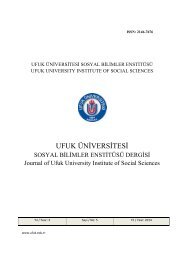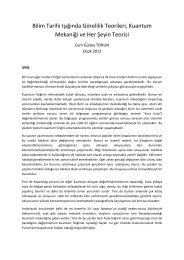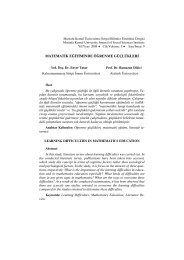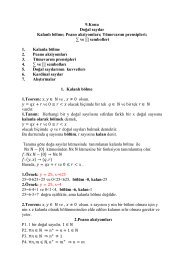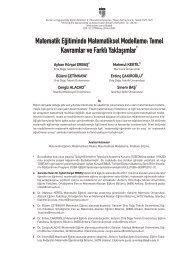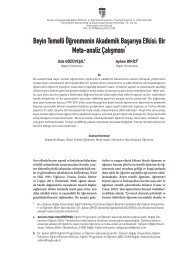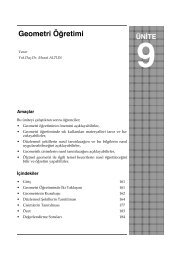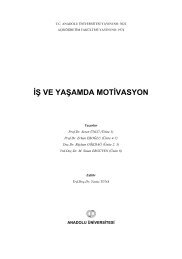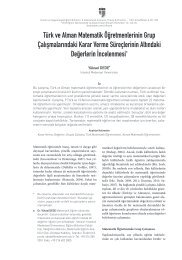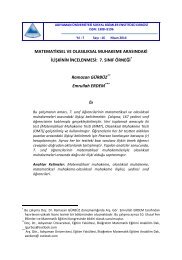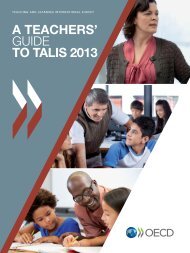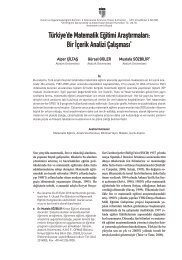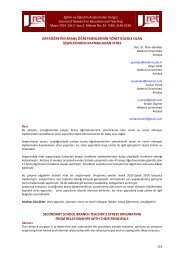NEWSLETTER
2015-12-98
2015-12-98
You also want an ePaper? Increase the reach of your titles
YUMPU automatically turns print PDFs into web optimized ePapers that Google loves.
Book Reviews<br />
to represent number in primary school and exemplary<br />
lessons under the curriculum reform.<br />
It is impossible to review all the chapters, hence information<br />
will only be given about one of the chapters:<br />
Achieving Coherence in the Mathematics Classroom:<br />
Toward a Framework for Examining Instructional Coherence<br />
(by Wang Tao, Cai Jinfa and Hwang Stephen).<br />
The chapter has three Chinese authors who live in the<br />
West. Hence, they combine the knowledge of Chinese<br />
culture and Western traditions of educational research.<br />
The abstract reads:<br />
Coherence has been identified as an important factor<br />
in fostering students’ learning of mathematics. In this<br />
chapter, by applying classroom discourse theories,<br />
we propose a framework for examining instructional<br />
coherence through a fine-grained analysis of a video-taped<br />
lesson from China. The lesson was chosen<br />
because it has been recognized as a model lesson for<br />
instructional coherence. Based on a careful analysis<br />
of instructional coherence on multiple levels of classroom<br />
discourse, we explored discourse strategies the<br />
teacher used to achieve instructional coherence in the<br />
classroom, as well as the features of classroom instruction<br />
in China. (p. 111)<br />
The lesson is about circles in the 6th grade. One can imagine<br />
that this lesson is the outcome of a cycle of “preparing,<br />
observing, reflecting and commenting” within a<br />
mathematics teaching research group (see above). Actually,<br />
coherence is a typical feature of a mathematics<br />
lesson in China. Having observed several cases of lessons<br />
in China, I have noticed that nothing happens by<br />
chance and that a careful design has been prepared. The<br />
chapter reports carefully about the global coherence of<br />
the overall narrative of the lesson, the episodic coherence<br />
of small episodes and the local coherence, about<br />
individual sentences or utterances and the sense given<br />
by the participants. The structure of a mathematics lesson<br />
in China is fixed: reviewing, teaching new content,<br />
student practice and assigning homework. Although<br />
Western observers may by critical about this fixed structure<br />
which may leave no space for improvisation (and<br />
creativity), it cannot be doubted that Chinese students<br />
perform better than Western students in international<br />
comparisons (e.g. PISA or TIMSS).<br />
The third and last part of the volume focuses on<br />
Chinese mathematics teachers, teacher education and<br />
teacher professional development. In this part, some<br />
studies are reported about teachers’ beliefs and professional<br />
development.<br />
As above, the offering is very rich and it is not possible<br />
to review all the chapters. In this case, the selection<br />
is: What Makes a Master Teacher? A Study of Thirty-One<br />
Mathematics Master Teachers in Chinese Mainland (by<br />
Fan Linghuo, Zhu Yuan and Tang Caibin). A master<br />
teacher is typical of the Chinese instruction system (and<br />
of other Far East systems like in Japan and Singapore).<br />
‘Master teacher’ as an honorary title has been used<br />
to recognize teachers’ outstanding performance in the<br />
Chinese mainland since 1978 when the system was initiated.<br />
This title does not belong to the official career<br />
rank system for teachers, which was not established<br />
until the mid-1980s. (p. 493)<br />
Now, three levels characterise the official career rank<br />
system: “second grade” (or junior grade), “first grade”<br />
(or middle grade) and “senior grade” (or higher grade).<br />
Master teachers are regarded as models for other teachers.<br />
They are believed to have a systematic understanding<br />
of mathematics, know how to integrate mathematics<br />
education theories and psychology into classroom<br />
teaching, pay attention to mathematics as a culture and<br />
be able to analyse textbooks with deep understanding.<br />
The figure of master teacher is important in the Chinese<br />
school, as the number of studies (in Chinese) mentioned<br />
in this chapter shows. The main study reported<br />
in this chapter aims to investigate the reasons behind<br />
the success of mathematics master teachers in their acclaimed<br />
teaching career on the Chinese mainland. The<br />
study investigates the master teachers’ beliefs in analysing<br />
their own professional success. From the interview<br />
of 31 mathematics master teachers (mostly from<br />
primary school), dedication to education, inner quality<br />
and true professional care toward students appear to be<br />
the three most important factors. Reflection (like that<br />
carried out in the open classes mentioned above) was<br />
considered the most important pathway for teachers to<br />
seek professional development, while various formal<br />
training and short-term training was considered to be<br />
less effective. This result is consistent with the second<br />
chapter reviewed above.<br />
Finally, in the epilogue of the volume: ‘Why the Interest<br />
in the Chinese Learner?’, the volume editors summarise<br />
the motives for publishing the two twin books How<br />
Chinese Learn Mathematics and How Chinese Teach<br />
Mathematics? to meet the public’s interest in the big<br />
success of Chinese mathematics education in international<br />
assessments. In their opinion, these books serve<br />
at least the following purposes:<br />
(1) Letting the researchers on Chinese mathematics<br />
education discuss their own views, experiences<br />
and interested issues in mathematics education.<br />
(2) Telling the world the ‘Chinese story’ and responding<br />
to their queries.<br />
(3) Having Chinese and non-Chinese, who also have<br />
interest and passion in Chinese mathematics education,<br />
join hands to discuss issues in mathematics<br />
education worldwide. (p. 706)<br />
I belong to the last group as a non-Chinese scholar with<br />
an interest and passion in Chinese mathematics education.<br />
My personal interaction with Chinese mathematics<br />
education, either in personal visits or in reading reports<br />
like the ones of this volume, has convinced me that I<br />
have better understood my system by looking at the different<br />
choices made in the Chinese system. Following<br />
Jullien, a famous French philosopher and Sinologue, we<br />
EMS Newsletter December 2015 69




